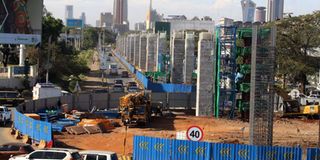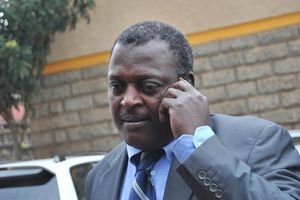Premium
Big projects came up despite Covid-19 crisis

Members of the National Youth Service with Likoni residents during the launch of the Likoni floating bridge at Liwatoni, Mombasa County, on December 25, 2020.
It might have been a turbulent year for global economies owing to the Covid-19 pandemic, but 2020 saw Kenya cement its position as the regional infrastructural hub, with multiple projects commissioned, some completed and others unveiled for public use.
In the second last year of his tenure, President Uhuru Kenyatta underscored his government’s commitment to transforming the country’s infrastructure. The President personally supervised works on some of the projects that will certainly shape his legacy.
We take a look at some of the infrastructural projects that defined the year and what they mean for Kenya’s economy.
This 1.2-kilometre bridge in Mombasa, constructed at a cost of Sh1.9 billion, was the highlight of Kenya’s infrastructural milestones in 2020.
The bridge was constructed to ease pressure on the Likoni channel, which has traditionally been served by ferries.
Nearly 300,000 pedestrians and 6,000 vehicles cross the channel every day, with peak hours particularly chaotic.
A first of its kind in East and Central Africa, the bridge has a six-metre-wide deck and a 715-metre-long floating section. The middle section has a 150-metre movable gate.
It’s through this section, to be opened and shut by tag boats, that ships entering and leaving the port through the channel will use.
The bridge that runs from Liwatoni to Bofu was opened for public use on Christmas day. Hundreds seized the opportunity to take photos to capture the moment.
Construction of the expressway, which will run through Nairobi from Jomo Kenyatta International Airport (JKIA) to Westlands, finally started this year.
The project that is being undertaken by China Road and Bridge Company (CRBC) at a cost of Sh65 billion will be completed by end of 2021, according to the Kenya National Highways Authority (KeNHA).
During a tour of the project in mid-December, Transport CS James Macharia announced that it was 15 per cent complete.
The highway that will tremendously transform the city’s landscape is expected to slash the time spent to travel the 27-kilometre stretch between the eastern and western parts of the capital.
The government intends to extend the highway to Machakos.
The project hasn’t been without controversy, with several iconic landmarks in the city, including Lunar Park, demolished to give way for the multibillion-shilling project.
Tens of trees have also been cut down along Uhuru and Waiyaki ways.

Construction of the Nairobi Expressway along Mombasa Road as pictured on December 29, 2020.
After three years of renovations at a staggering cost of Sh650 million, President Kenyatta reopened Nyayo National Stadium for use in September this year, describing the occasion as “the first page in a new chapter of sports in Kenya”.
The upgrading of the 30,000-seater stadium included installation of seats, a departure from the past where spectators would sit on concrete slabs, and revamping of the VIP section. Players’ locker rooms were also refurbished. Grass in the facility has since been trimmed to lend the pitch a fresh look.
The stadium plays a key role in hosting major sporting and national events due to its centrality and ease of access.
Kenya had hoped to host the Africa Cup of Nations in 2018, but owing to slow restoration works, the Confederation of African Football (CAF) was unimpressed, moving the championships to Morocco.
In January this year, the government set aside Sh3 billion for the refurbishment of the 240-kilometre line laid in the 1920s by the colonial government.
The rail is expected to revive trade, tourism and transport in a region popular with horticulture, dairy, beef, coffee and tea farming.
Mount Kenya region contributes 20 per cent of the country’s Gross Domestic Product (GDP), according to findings by the Kenya National Bureau of Statistics (KNBS) in 2019.
For more than a decade after the rail fell into disuse, termini along the route quickly became ghost structures. Farmers invaded the railway reserve and introduced crops while traders built structures on top of the line.
Laikipia Governor Ndiritu Muriithi said the return of the Nairobi-Nanyuki train service couldn’t have come at a better time for the region.
“Transport infrastructure is a big enabler of trade, tourism, production and distribution of goods. Rail transport will significantly lower the cost of transporting local produce to Nairobi and other markets,” said Governor Muriithi.
During the festive season, Kenya Railways added more trains on the route to cater for the surge in the number of travellers.

Kenya Railways crew work repair a train that broke down at Ruthagati in Mathira, Nyeri County, on December 27, 2020.
The dream of owning a home for thousands of Kenyans got a boost this year as the ambitious affordable housing programme (AHP) by the Jubilee government to construct 500,000 housing units in five years took shape.
The first instalment of the project, Park Road in Ngara, with a total of 1,370 homes, was expected to be completed by the end of 2020.
More housing units will be put up in Starehe, Kibra-Soweto and at Mariguini Informal Settlement. Others are Mavoko Sustainable Housing Programme, National Housing Corporation (NHC) Stoni in Athi River.
Most of the projects are in various stages of development. Land has already been acquired for those that are yet start.
In President Uhuru Kenyatta’s second and final term, his administration had identified housing as one of the key pillars of the economy. The programme would involve government and institutional housing, slum upgrading and private development projects to offer quality and affordable housing to Kenyans.
Already, 312,739 Kenyans have registered under the Boma Yangu scheme, awaiting allocation.
This year, Kenya Railways revamped the Nairobi Commuter Rail Service (NCRS) and refurbished Diesel Multiple Units (DMUs).
The project that’s part of the Nairobi Metropolitan Transport (NMS) Master Plan, consisting of new 11 DMUs and Commuter Rail Buses, is expected to modernise and expand the utilisation of railway transport in the city.
Launching the project in early November, President Kenyatta noted that it would help ease pressure on city roads, thus reducing endemic traffic jams.
About 13,000 passengers used this rail service daily in 2020, findings of the International Railway Journal show.
The Nairobi Commuter Rail Service will create an efficient and affordable mass rapid transit transport system for the city while integrating the rail transport with other modes of transport in the country, Kenya Railways said.
Kenya-Ethiopia One Stop Border Post
After a three-year standoff, Kenya and Ethiopia finally inaugurated a One Stop Border Post (OSBP) in Moyale town, Marsabit County, in a move aimed at facilitating trade between the two neighbours.
A One Stop Border Post is a border crossing point where immigration officials of two countries operate under one roof to facilitate trade and movement of people.
While Kenya and her northern landlocked neighbour share a border stretching over 830 kilometres, the new border post is the only such border.
The key installation that cost Sh800 million was unveiled during Ethiopia Premier Abiy Ahmed’s two-day visit to Kenya in early December.
The border post had been completed in 2018, but the launch was delayed following tensions in the vast region.
Terror and insecurity have characterised the border between the two countries. Besides improving trade partnerships, the two heads of state committed to restoring peace in the restive region.
President Kenyatta and Prime Minister Ahmed also opened the 500km Nairobi-Addis Ababa road corridor.

President Uhuru Kenyatta witnesses the loading of 11 wagons of industrial sugar onto MV Uhuru, for transportation to Uganda, during an inspection tour of the Kisumu port on October 22, 2020.
After many years of waiting, works to restore Kisumu port started in 2019 and were competed in 2020, in what observers say was the spirit of the handshake between President Kenyatta and ODM leader Raila Odinga at work.
The port yard was cast in concrete, a quayside constructed and the linkspan repaired. Additionally, the dry dock was refurbished while port buildings were also renovated.
The government further invested in forklift trucks, mobile cranes, tractor-trailers and other modern equipment to boost efficiency at the port.
The Kenya Defence Forces, Kenya Ports Authority (KPA), and the National Youth Service (NYS) will facilitate transport at the port that’s also expected to boost domestic and international tourism.
Moreover, there are ongoing repair works on the port section of the 217-kilometre Nakuru-Kisumu railway line, being carried out by National Youth Service personnel at a staggering Sh3.8 billion.
The port, which is connected to Kenya Pipeline’s Kisumu depot, is expected to ease transportation of fuel to Uganda. At the moment, trucks ferry oil to the country.
While only 19 vessels used the port in 2018, the renovation attracted 41 vessels in 2019, a 116 per cent increase. By August 2020, the port had recorded a 62 per cent rise in cargo since the refurbishment.
Beautification of Nairobi
For many visitors to Nairobi, the Kenyan capital has transformed immensely in the past couple of months, thanks to the ongoing renovation works.
The project has seen city roads repaired and carpeted afresh, pedestrian paths built and cabro blocks installed in large swathes of the Central Business District.
This upgrade is being done through a partnership between the Mohamed Badi-led Nairobi Metropolitan Services and the national government.
The works seem to have the blessings of the highest office in the land, with President Kenyatta spotted on different occasions along Kenyatta Avenue and Kirinyaga Road on tours to inspect progress of the projects.
By hiving off sections of the city streets to create room for pedestrians, the programme also aims to regulate the number of motorists accessing the city every day.





